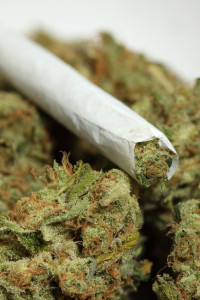 Marijuana is a product of the Cannabis plant. Cannabis or “marijuana” is a natural herb that is usually ingested as a recreational drug but sometimes as a prescribed drug to treat specific medical conditions. Marijuana is also known by hundreds of other slang names; common names include “pot”, “weed” and “skunk”. It is usually ingested by smoking or eating. It can be made into a tea or combined with foods such as sweets, oil or butter. It can be applied to the skin when made into a moisturizer. It is sometimes, but rarely, ingested by boiling the leaves and injecting the broth – a particularly dangerous way of ingesting the substance.
Marijuana is a product of the Cannabis plant. Cannabis or “marijuana” is a natural herb that is usually ingested as a recreational drug but sometimes as a prescribed drug to treat specific medical conditions. Marijuana is also known by hundreds of other slang names; common names include “pot”, “weed” and “skunk”. It is usually ingested by smoking or eating. It can be made into a tea or combined with foods such as sweets, oil or butter. It can be applied to the skin when made into a moisturizer. It is sometimes, but rarely, ingested by boiling the leaves and injecting the broth – a particularly dangerous way of ingesting the substance.
Effects of Marijuana
Marijuana has positive side effects that recreational users enjoy. Ingesting the herb uplifts the mood and brings about a sense of euphoria in some users. Users experience relaxation and calm as the blood pressure is lowered. Some users experience an increase in creativity and insight.
Marijuana’s negative side effects can be numerous depending on how the user’s body reacts to the substance. Short-term memory, coordination and concentration are usually temporarily impaired. “Cotton mouth”, red eyes, anxiety, paranoia and increased heart rate can also occur.
Marijuana use over the long-term has questionable effects. Respiratory damage in chronic users has been reliably documented. Researchers are still studying the possible links between marijuana, various brain chemistry imbalances and mental disorders and heart disease.
Medical Uses of Marijuana
The drug’s positive side effects can be utilized to treat a variety of medical conditions. Man-made cannabinoid-based drugs are prescribed under various brand names (“Marinol” in the U.S.). Conditions that have been treated with marijuana include:
- Nausea, vomiting
- Severe loss of appetite in patients undergoing certain medical treatments
- Glaucoma, pain relief, multiple sclerosis
- Depression
Legal Status of Marijuana
In the United States, marijuana is illegal under federal law. Because growing marijuana outdoors brings risk of prosecution in most areas of the United States, indoor growing techniques such as the use of powerful indoor lighting, hydroponics and cloning have emerged and become more sophisticated.
Washington and Colorado are the first states thus far that have legalized marijuana into state law. It is likely that more states will follow.
Marijuana Addiction
Some researchers have ranked the addictive potential of marijuana as being lower than that of caffeine. People with the highest risk of developing an addiction include teenagers and people with mental disorders. Nevertheless, chronic users will experience obsession with the drug and tolerance for more and more of the drug over time. Withdrawal symptoms will be experienced if usage is stopped. Withdrawal from marijuana is primarily psychological so detox is usually not necessary unless the individual has co-existing addictions, such as alcoholism. Marijuana can be detected in a variety of drug tests/body fluids and stays in a user’s system for weeks.


